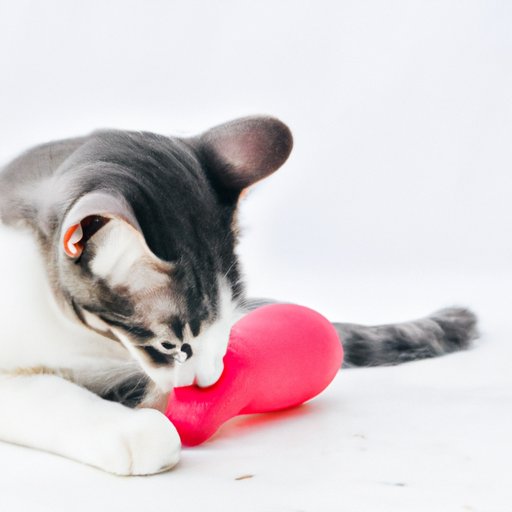Introduction
Cats are known for their quirky behaviors, one of which is their tendency to chew on plastic. While it may seem harmless at first, this behavior can have serious health implications for your feline friend. In this article, we’ll explore why cats may be attracted to plastic and provide tips and solutions for cat owners to help prevent this behavior.
The Top Reasons Why Your Cat May Be Obsessed with Plastic: A Comprehensive Guide
There are a few reasons why cats may be attracted to plastic. One of the main reasons is the texture – plastic can feel satisfying to chew on for some cats. Other cats may be attracted to the crinkling sound that plastic makes when it’s chewed on. Finally, some cats may be drawn to the taste of plastic.
If you’ve ever caught your cat chewing on plastic, you’re not alone. Many cat owners report that their feline friends have an affinity for all kinds of plastic items, from bags and wrappers to cords and cables. Some cats even go as far as gnawing on plastic furniture or plants.
To prevent your cat from chewing on plastic, it’s important to understand the underlying reasons behind this behavior. If your cat is bored or anxious, they may be more likely to turn to plastic as a way to alleviate stress or pass the time.
If you’re dealing with a plastic-chewing cat, there are some solutions that can help. Providing your cat with plenty of toys, playtime, and mental stimulation can help reduce the urge to chew on plastic. Additionally, keeping all plastic items out of reach can help prevent accidents.
The Hidden Dangers of Your Cat’s Plastic Chewing Habit
While plastic chewing may seem harmless, it can actually pose serious health risks to your cat. Plastic can be sharp and jagged when chewed on, increasing the risk of choking or injury to the mouth, throat, or digestive tract. If a cat swallows a large piece of plastic, it can become lodged in the intestines, leading to a blockage and potential surgical intervention.
Furthermore, many types of plastic contain harmful chemicals that can be toxic to cats if consumed in large quantities. This can cause a range of health problems, from vomiting and diarrhea to more serious issues like liver or kidney damage.
If you suspect that your cat has ingested plastic, it’s important to seek veterinary help right away. Your vet can perform an X-ray to determine whether there’s a blockage and recommend appropriate treatment options.
From Boredom to Anxiety: Exploring the Psychology Behind Your Cat’s Plastic Obsession
While it’s not entirely clear why cats may be attracted to plastic, there are a few underlying psychological factors that may contribute to this behavior. Some cats may chew on plastic as a way to alleviate boredom or reduce stress. Others may be drawn to plastic as a way to satisfy their natural urge to chew. Finally, some cats may be using plastic as a way to self-soothe or comfort themselves.
If you suspect that your cat’s plastic-chewing behavior is linked to an underlying psychological issue, there are a few things you can do to help. Providing your cat with plenty of mental and physical stimulation can help alleviate boredom and anxiety. Additionally, you may want to consider investing in a few interactive toys or puzzle feeders to keep your cat engaged and entertained.
How to Break the Plastic-Chewing Habit: Tips and Tricks for Cat Owners
If your cat is already in the habit of chewing on plastic, breaking the behavior can be challenging but not impossible. One of the most effective ways to prevent your cat from chewing on plastic is to simply remove it from their environment. Store all plastic items out of reach, or invest in a few plastic-free alternatives.
Another strategy is to provide your cat with plenty of alternatives to plastic. There are a variety of chew toys and treats available that are designed specifically for cats. Experiment with different textures and shapes to find what your cat likes best.
Finally, consider using positive reinforcement to encourage your cat to break the habit. When your cat successfully avoids chewing on plastic, offer praise, treats, or playtime. Over time, your cat will learn that plastic is not a desirable chew item.
Plastic Alternatives: Safe and Fun Toys for Your Cat to Chew On
If you’re looking for safe and fun alternatives to plastic, there are many options available. Some cats enjoy chewing on natural materials like wood or cork. Others prefer rubber or silicone toys. Experiment with different textures and materials to find what your cat likes best.
In addition to chew toys, puzzle feeders can also be a great way to keep your cat entertained and engaged. These toys require cats to work for their food, which can be a fun and rewarding challenge. Just be sure to choose puzzle feeders that are made from safe and durable materials.
A Vet’s Perspective: Understanding and Treating Your Cat’s Plastic Eating Behavior
If your cat’s plastic chewing behavior persists or becomes a serious health concern, it’s important to seek veterinary help. Your vet can perform a thorough exam to determine whether there’s an underlying medical issue that needs to be addressed.
Depending on the severity of the behavior, your vet may recommend behavioral therapy or medication to help alleviate anxiety or stress. In some cases, surgery may be necessary to remove a plastic blockage from the digestive tract.
Conclusion
If your cat has a tendency to chew on plastic, don’t panic. By understanding the reasons behind this behavior and taking proactive steps to prevent it, you can help keep your feline friend safe and happy. Remember to provide plenty of toys and mental stimulation, remove plastic items from your cat’s environment, and seek veterinary help if necessary. With a little patience and persistence, you can help your cat break the plastic-chewing habit for good.
